#Mauna Loa CO2 data
Explore tagged Tumblr posts
Text

🌎 422.42 ppm #CO2 in the planet's air for the 33rd week of 2024 📈 Up from 419.03 one year ago📈
🔗 @NOAA Mauna Loa weekly data:

#Climate Change#Climate Crisis#Climate Goals#Protect The Planet#There Is No Planet B#Climate Change Reporting#Climate Journalism#Covering Climate Crisis#Our Home In Space#Fossil Fuel Caused Climate Change#Clean Energy Now#Climate Activists#Climate Activism#Global CO2 levels#Mauna Loa CO2 data#NOAA GML#CO2 Earth#CO2.earth
2 notes
·
View notes
Text
Hawaii’s Mauna Loa Observatory just captured ominous signals about the planet’s health. (Washington Post)

Hawaii’s Mauna Loa Observatory just captured an ominous sign about the pace of global warming.
Atmospheric levels of planet-warming carbon dioxide aren’t just on their way to yet another record high this year — they’re rising faster than ever, according to the latest in a 66-year-long series of observations.
Carbon dioxide levels were 4.7 parts per million higher in March than they were a year earlier, the largest annual leap ever measured at the National Oceanic Atmospheric Administration laboratory atop a volcano on Hawaii’s Big Island. And from January through April, CO2 concentrations increased faster than they have in the first four months of any other year.��Data from Mauna Loa is used to create the Keeling Curve, a chart that daily plots global atmospheric carbon dioxide concentration, tracked by Scripps Institution of Oceanography at the University of California at San Diego.
For decades, CO2 concentrations at Mauna Loa in the month of May have broken previous records. But the recent acceleration in atmospheric CO2, surpassing a record-setting increase observed in 2016, is perhaps a more ominous signal of failing efforts to reduce global greenhouse gas emissions and the damage they cause to Earth’s climate.
“Not only is CO2 still rising in the atmosphere — it’s increasing faster and faster,” said Arlyn Andrews, a climate scientist at NOAA’s Global Monitoring Laboratory in Boulder, Colo.
A historically strong El Niño climate pattern that developed last year is a big reason for the spike. But the weather pattern only punctuated an existing trend in which global carbon emissions are rising even as U.S. emissions have declined and the growth in global emissions has slowed.
Each annual maximum has raised new alarm about the curve’s unceasing upward trend — nearing 427 parts per million in the most recent readings, which is more than 50 percent above preindustrial levels and the highest in at least 4.3 million years, according to NOAA. Atmospheric CO2 levels first surpassed 400 parts per million in 2014. Scientists said in 2016 that levels were unlikely to drop below that threshold again during the lifetime of even the youngest generations.
Since that year, carbon dioxide emissions tied to fossil fuel consumption have increased 5 percent globally, according to Scripps.
13 notes
·
View notes
Text
At the time of writing it is 422.36 parts per million. That is 5.06ppm more than the same day last year. That rise in 12 months is probably the largest ever recorded – more than double the last decade’s annual average. To give some perspective, exactly a decade ago the concentration was 395.64ppm. Then the scientific community worried about the effect on the weather if we were to pass the 400 mark. Now we know: the result is catastrophic heatwaves, storms, droughts, floods and rapidly increasing and unstoppable sea level rise.
2 notes
·
View notes
Note
TELL ME ABOUT THE ICE CORES I WOULD LOVE TO HEAR ABOUT THEM
/takes a break from writing an essay (only 600 words in. sad.) to write even more words about,, ice/
yahoo !!!!1
ice cores are mostly used for monitoring changing CO2 levels in the atmosphere along with methane and nitrous oxide :) by taking out looooooong chunks of ice from glaciers and ice sheets, you can analyze things that happened a long time ago!! air bubbles trapped inside the ice contain our ancient atmosphere! the stuff that creatures 2 million years ago breathed!!!! and we can analyze the contents of it!!!!!!!!!!
volcanic eruptions and weather events such as dust storms can be trapped in the ice too! particulate matter is chemically documented and linked with CO2 contents to create graphs of ancient climates (volcanoes make the earth cool since solar radiation cannot enter the atmosphere as easily when blocked out by large amounts of ash, so we can identify probable dips in the earth's previous temperatures!)
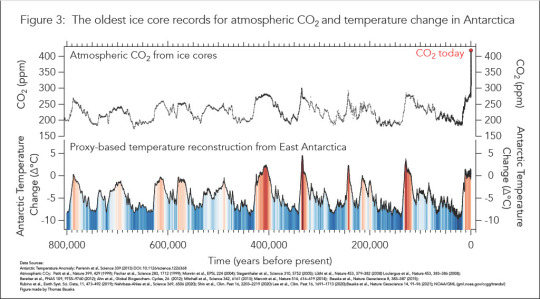
image source (displays how climate matches up nicely with air bubble samples taken from the cores!!)
with this science we've accurately documented around 400,000 years worth of natural climate data from the past!!!!!! of course other resources are compared such as tree ring growth and plant frost damage, but it's all collaborative to become as accurate as possible :)
speaking of plant growth, the ice cores gave us the keeling curve! named after Dr. Dave Keeling, who took the first ice core measures at Mauna Loa in Hawaii in 1858 due to wanting an "uncontaminated" sample as humanly possible. the ice core CO2 data showed a natural fluctuation with the seasons, a pretty little pattern of crests and troughs created as plants flourish in the summer to consume CO2 and die off in the winter to allow it to more accumulate. after Keeling continued to document samples, he found the CO2 levels to steadily rise (he expected his graph's slope to be flat! being sampled so far away from major city pollutants! whats going on!!?)
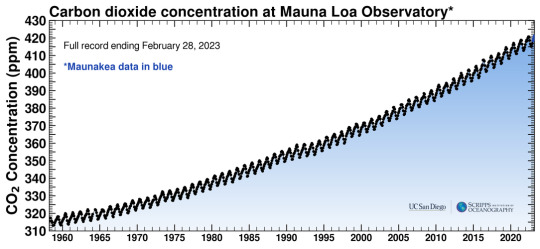
image source (interactive charts are fun :D ..... the fully extended one also scares the shit out of me :D !!)
so now ice core data and the continued documentation of the extended keeling curve have become an international effort in order to 1- further research our past climate by going deeper and deeper to analyze more ancient cores (currently being stored and researched at the main ice core facility in Colorado USA (i watched a documentary on this place it was very cool!!!)) and 2- keep watch on the keeling curve in relation to climate change and the efforts to reduce it (ex: the IPPC, Kyoto protocol, Paris agreement, etc. etc. etc. and how their impacts, well,, impact this data)
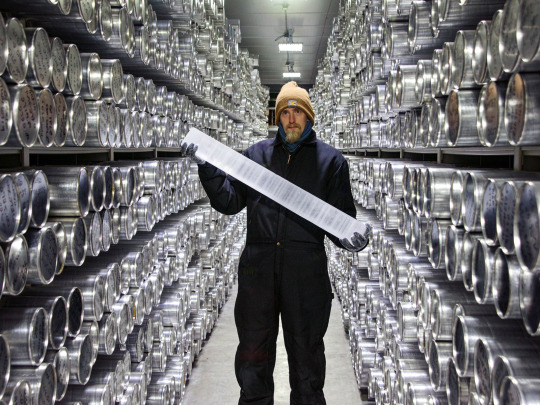
LOOK HOW MANY THERE ARE IN THIS FACILITY!!!!! THIS PLACE IS SO SO SO SO SICK I WANNA GO SO BAD (image pulled from this short (but out of date) magazine article)
i had more graphics from my university but theyre from a year ago and i no longer have access to the old files but they were SOOOO COOOOL
being a stem kid with adhd is so cool and fun 11/10 would recommend (all my friends are liberal arts majors and i talked to them in a starbucks about BPA once for over 30 minutes straight god bless them) i love sharing information thank you so much anon i can always rely on the tumblr followers to talk about cool things :)

(reason this journal is so unusually long is bc it's part of a collection of 2021-2022's "best of" but im really enjoying it so far)
BUT!
now i have to go back and do my essay. i enjoyed this break dearly :)
4 notes
·
View notes
Text

Join the fight against the Climate Crisis: Understanding the Impact of CO2 Emissions
Our planet is in trouble. Every moment, carbon dioxide levels rise, throwing Earth's balance off-kilter. From the time we started burning fossil fuels during the Industrial Revolution to today's worrying 420 ppm, we've been speeding up global warming.
The proof is clear: data from places like Mauna Loa shows it, as does animated maps illustrating how CO2 levels are changing. We see the facts: temperatures are rising, weather patterns are getting wilder, and nature struggles to cope with all the CO2.
We need to act now. Switching to renewable energy, using energy more wisely, keeping track of your carbon footprint, and aiming to reduce emissions; they're things we have to do to save our planet. Let's work together to change the story of our climate and make sure our future is healthier.
#sustainability#climekare#carbonimpact#carbonpositive#CO2#sustainableliving#environment#carbonemmsion#carbonfoodprint
0 notes
Photo

13 Misconceptions About Global Warming Common misconceptions about climate change. Check out Audible: http://bit.ly/AudibleVe References below: For CO2, sea levels, Arctic sea ice, Antarctic and Greenland land ice: http://climate.nasa.gov Satellite data shows that ground-based stations underestimate recent warming: Cowtan and Way, 2014 http://onlinelibrary.wiley.com/doi/10.1002/qj.2297/full For papers published on climate change during the 1970's, see Peterson, 2008 http://ams.confex.com/ams/pdfpapers/131047.pdf For solar and temperature data see NASA GISS, PMOD: http://www.acrim.com/tsi%20monitoring.htm Krivova et al. 2007: http://www2.mps.mpg.de/projects/sun-climate/data.html CO2 ratio of Carbon-13:Carbon-12 decreasing. IPCC AR4: http://www.ipcc.ch/publications_and_data/ar4/wg1/en/ch2s2-3.html CO2 emitted by volcanoes vs by humans: Gerlach, 2011 www.agu.org/pubs/pdf/2011eo240001.pdf Gerlach Mauna Loa CO2 data: http://www.esrl.noaa.gov/gmd/ccgg/trends/ Rising atmospheric water vapour: Santer, 2007 http://www.pnas.org/cgi/reprint/0702872104v1.pdf A doubling of CO2 will likely lead to a 3C increase in global temperatures according to many independent pieces of evidence: Knutti & Hegerl, 2008 http://www.iac.ethz.ch/people/knuttir/papers/knutti08natgeo.pdf Great resource on Milankovitch cycles: http://www.sciencecourseware.org/eec/GlobalWarming/Tutorials/Milankovitch/ CO2 lags temperature rise in the southern hemisphere but leads the global average temperature rise, Shakun et al. 2012 http://www.nature.com/nature/journal/v484/n7392/abs/nature10915.html Music by Kevin McLeod, http://incompetech.com Songs: Hidden Agenda, Sneaky Snitch, Harlequin
0 notes
Text
AutoBNN: Probabilistic time series forecasting with compositional bayesian neural networks
New Post has been published on https://thedigitalinsider.com/autobnn-probabilistic-time-series-forecasting-with-compositional-bayesian-neural-networks/
AutoBNN: Probabilistic time series forecasting with compositional bayesian neural networks
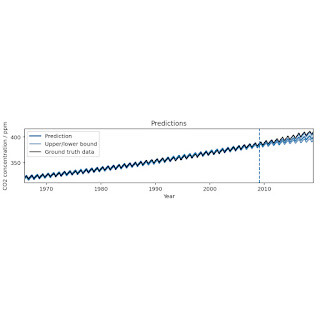
Posted by Urs Köster, Software Engineer, Google Research

Time series problems are ubiquitous, from forecasting weather and traffic patterns to understanding economic trends. Bayesian approaches start with an assumption about the data’s patterns (prior probability), collecting evidence (e.g., new time series data), and continuously updating that assumption to form a posterior probability distribution. Traditional Bayesian approaches like Gaussian processes (GPs) and Structural Time Series are extensively used for modeling time series data, e.g., the commonly used Mauna Loa CO2 dataset. However, they often rely on domain experts to painstakingly select appropriate model components and may be computationally expensive. Alternatives such as neural networks lack interpretability, making it difficult to understand how they generate forecasts, and don’t produce reliable confidence intervals.
To that end, we introduce AutoBNN, a new open-source package written in JAX. AutoBNN automates the discovery of interpretable time series forecasting models, provides high-quality uncertainty estimates, and scales effectively for use on large datasets. We describe how AutoBNN combines the interpretability of traditional probabilistic approaches with the scalability and flexibility of neural networks.
AutoBNN
AutoBNN is based on a line of research that over the past decade has yielded improved predictive accuracy by modeling time series using GPs with learned kernel structures. The kernel function of a GP encodes assumptions about the function being modeled, such as the presence of trends, periodicity or noise. With learned GP kernels, the kernel function is defined compositionally: it is either a base kernel (such as Linear, Quadratic, Periodic, Matérn or ExponentiatedQuadratic) or a composite that combines two or more kernel functions using operators such as Addition, Multiplication, or ChangePoint. This compositional kernel structure serves two related purposes. First, it is simple enough that a user who is an expert about their data, but not necessarily about GPs, can construct a reasonable prior for their time series. Second, techniques like Sequential Monte Carlo can be used for discrete searches over small structures and can output interpretable results.
AutoBNN improves upon these ideas, replacing the GP with Bayesian neural networks (BNNs) while retaining the compositional kernel structure. A BNN is a neural network with a probability distribution over weights rather than a fixed set of weights. This induces a distribution over outputs, capturing uncertainty in the predictions. BNNs bring the following advantages over GPs: First, training large GPs is computationally expensive, and traditional training algorithms scale as the cube of the number of data points in the time series. In contrast, for a fixed width, training a BNN will often be approximately linear in the number of data points. Second, BNNs lend themselves better to GPU and TPU hardware acceleration than GP training operations. Third, compositional BNNs can be easily combined with traditional deep BNNs, which have the ability to do feature discovery. One could imagine “hybrid” architectures, in which users specify a top-level structure of Add(Linear, Periodic, Deep), and the deep BNN is left to learn the contributions from potentially high-dimensional covariate information.
How might one translate a GP with compositional kernels into a BNN then? A single layer neural network will typically converge to a GP as the number of neurons (or “width”) goes to infinity. More recently, researchers have discovered a correspondence in the other direction — many popular GP kernels (such as Matern, ExponentiatedQuadratic, Polynomial or Periodic) can be obtained as infinite-width BNNs with appropriately chosen activation functions and weight distributions. Furthermore, these BNNs remain close to the corresponding GP even when the width is very much less than infinite. For example, the figures below show the difference in the covariance between pairs of observations, and regression results of the true GPs and their corresponding width-10 neural network versions.
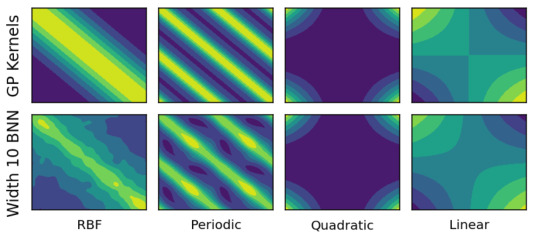
Comparison of Gram matrices between true GP kernels (top row) and their width 10 neural network approximations (bottom row).
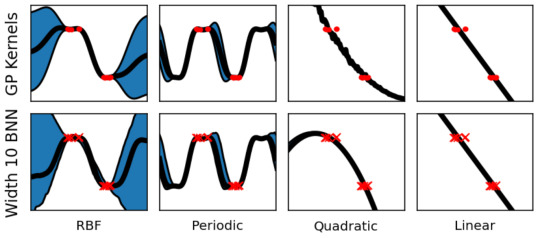
Comparison of regression results between true GP kernels (top row) and their width 10 neural network approximations (bottom row).
Finally, the translation is completed with BNN analogues of the Addition and Multiplication operators over GPs, and input warping to produce periodic kernels. BNN addition is straightforwardly given by adding the outputs of the component BNNs. BNN multiplication is achieved by multiplying the activations of the hidden layers of the BNNs and then applying a shared dense layer. We are therefore limited to only multiplying BNNs with the same hidden width.
Using AutoBNN
The AutoBNN package is available within Tensorflow Probability. It is implemented in JAX and uses the flax.linen neural network library. It implements all of the base kernels and operators discussed so far (Linear, Quadratic, Matern, ExponentiatedQuadratic, Periodic, Addition, Multiplication) plus one new kernel and three new operators:
a OneLayer kernel, a single hidden layer ReLU BNN,
a ChangePoint operator that allows smoothly switching between two kernels,
a LearnableChangePoint operator which is the same as ChangePoint except position and slope are given prior distributions and can be learnt from the data, and
a WeightedSum operator.
WeightedSum combines two or more BNNs with learnable mixing weights, where the learnable weights follow a Dirichlet prior. By default, a flat Dirichlet distribution with concentration 1.0 is used.
WeightedSums allow a “soft” version of structure discovery, i.e., training a linear combination of many possible models at once. In contrast to structure discovery with discrete structures, such as in AutoGP, this allows us to use standard gradient methods to learn structures, rather than using expensive discrete optimization. Instead of evaluating potential combinatorial structures in series, WeightedSum allows us to evaluate them in parallel.
To easily enable exploration, AutoBNN defines a number of model structures that contain either top-level or internal WeightedSums. The names of these models can be used as the first parameter in any of the estimator constructors, and include things like sum_of_stumps (the WeightedSum over all the base kernels) and sum_of_shallow (which adds all possible combinations of base kernels with all operators).

Illustration of the sum_of_stumps model. The bars in the top row show the amount by which each base kernel contributes, and the bottom row shows the function represented by the base kernel. The resulting weighted sum is shown on the right.
The figure below demonstrates the technique of structure discovery on the N374 (a time series of yearly financial data starting from 1949) from the M3 dataset. The six base structures were ExponentiatedQuadratic (which is the same as the Radial Basis Function kernel, or RBF for short), Matern, Linear, Quadratic, OneLayer and Periodic kernels. The figure shows the MAP estimates of their weights over an ensemble of 32 particles. All of the high likelihood particles gave a large weight to the Periodic component, low weights to Linear, Quadratic and OneLayer, and a large weight to either RBF or Matern.
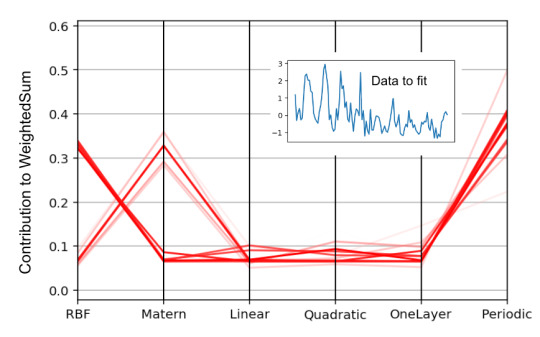
Parallel coordinates plot of the MAP estimates of the base kernel weights over 32 particles. The sum_of_stumps model was trained on the N374 series from the M3 dataset (insert in blue). Darker lines correspond to particles with higher likelihoods.
By using WeightedSums as the inputs to other operators, it is possible to express rich combinatorial structures, while keeping models compact and the number of learnable weights small. As an example, we include the sum_of_products model (illustrated in the figure below) which first creates a pairwise product of two WeightedSums, and then a sum of the two products. By setting some of the weights to zero, we can create many different discrete structures. The total number of possible structures in this model is 216, since there are 16 base kernels that can be turned on or off. All these structures are explored implicitly by training just this one model.
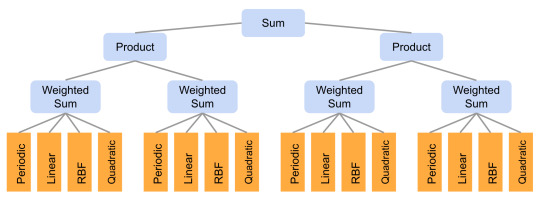
Illustration of the “sum_of_products” model. Each of the four WeightedSums have the same structure as the “sum_of_stumps” model.
We have found, however, that certain combinations of kernels (e.g., the product of Periodic and either the Matern or ExponentiatedQuadratic) lead to overfitting on many datasets. To prevent this, we have defined model classes like sum_of_safe_shallow that exclude such products when performing structure discovery with WeightedSums.
For training, AutoBNN provides AutoBnnMapEstimator and AutoBnnMCMCEstimator to perform MAP and MCMC inference, respectively. Either estimator can be combined with any of the six likelihood functions, including four based on normal distributions with different noise characteristics for continuous data and two based on the negative binomial distribution for count data.

Result from running AutoBNN on the Mauna Loa CO2 dataset in our example colab. The model captures the trend and seasonal component in the data. Extrapolating into the future, the mean prediction slightly underestimates the actual trend, while the 95% confidence interval gradually increases.
To fit a model like in the figure above, all it takes is the following 10 lines of code, using the scikit-learn–inspired estimator interface:
import autobnn as ab model = ab.operators.Add( bnns=(ab.kernels.PeriodicBNN(width=50), ab.kernels.LinearBNN(width=50), ab.kernels.MaternBNN(width=50))) estimator = ab.estimators.AutoBnnMapEstimator( model, 'normal_likelihood_logistic_noise', jax.random.PRNGKey(42), periods=[12]) estimator.fit(my_training_data_xs, my_training_data_ys) low, mid, high = estimator.predict_quantiles(my_training_data_xs)
Conclusion
AutoBNN provides a powerful and flexible framework for building sophisticated time series prediction models. By combining the strengths of BNNs and GPs with compositional kernels, AutoBNN opens a world of possibilities for understanding and forecasting complex data. We invite the community to try the colab, and leverage this library to innovate and solve real-world challenges.
Acknowledgements
AutoBNN was written by Colin Carroll, Thomas Colthurst, Urs Köster and Srinivas Vasudevan. We would like to thank Kevin Murphy, Brian Patton and Feras Saad for their advice and feedback.
#Advice#Algorithms#Blue#Building#classes#CO2#code#CoLab#Combinatorial#Community#comparison#continuous#data#datasets#direction#economic#Engineer#express#financial#flax#form#framework#Future#Google#GPS#gpu#Hardware#hardware acceleration#how#hybrid
0 notes
Text
Measurements from the Mauna Loa Observatory on Hawaii's Big Island averaged 424 parts per million (ppm) in May 2023, up 3 ppm on last year's May average, according to National Oceanic and Atmospheric Administration (NOAA) data. Atmospheric CO2 peaks in the Northern Hemisphere in May, and so that month is used as a benchmark. The new record builds on last year's all time high, pushing total atmospheric CO2 concentration to 50 per cent above pre-industrial levels. The observatory on Mauna Loa has measured atmospheric CO2 since 1958, when the level was less than 320 ppm.
Nick Kilvert, ‘Carbon dioxide in atmosphere hits new record high as scientists call for 'every effort to slash carbon pollution'’, ABC
1 note
·
View note
Text
Greenhouse gases from two regions in central Mexico
After reviewing the databases, I have decided to work with meteorological data from an environmental monitoring network. This network belongs to my university. Currently, I live in Mexico City (CDMX). This city is one of the largest and most populated in the world. Around 22 million inhabitants live in it (González del Castillo et al., 2022). Pollution is one of the main problems in megacities (SEDENA, 2018), without leaving aside the problem of water stress.

Figure 1: Particle pollution in Mexico City (aviable at https://www.ngenespanol.com/ecologia/ciudad-de-mexico-alcanza-niveles-historicos-de-contaminacion-por-particulas-suspendidas/).
I consider that my topic is of great importance and relevance, since it is currently known that in CDMX there is an increase of 2.4 ppm yr-1 registered since 2016 (Baylon et al., 2017). This increase is important since the last official CO2 measurements registered 407 ppm in 2018 (Friedlingstein et al., 2019). Although more current measurements indicate a concentration of ~420 ppm (TCOON, available at https://www.ruoa.unam.mx/).

Figure 2: Hourly means of Altzomoni XCO2 (FTIR ALTZ, black points) and Mauna Loa Observatory in situ CO2 (MLO, green points). From Baylon et al., (2017).
Although I am not sure about the analysis yet, the project proposal intends to show the variability of greenhouse gases, eg C02, in two regions of central Mexico. Suggested regions are; Mexico City (high pollution) and a “Contaminant Free” region, for example, the Altzomoni Atmospheric Observatory (ALTZ). The latter is characterized by being a protected natural area.

Figure 3: Aviable sites. The observatories chosen are UNAM (Mexico City) and the Altzomoni park (ALTZ).

Figure 4: Location of study sites. From González del Castillo et al., (2022).
There is the possibility of comparing CO2 data and its relationship with respiratory diseases, unfortunately these latest data are not available in my country. Although there is the possibility of comparing CO2 data with other meteorological variables, for example, wind speed, rainfall, suspended particles, etc.

Figure 5: Time series of the data available for the UNAM observatory. These data also exist for Altzomoni (ALTZ).

Figure 6: Example of the variables available in the datasets.
Literature:
Baylon, J. L., Stremme, W., Grutter, M., Hase, F., & Blumenstock, T. (2017). Background CO 2 levels and error analysis from ground-based solar absorption IR measurements in central Mexico. Atmospheric Measurement Techniques, 10(7), 2425-2434.
Friedlingstein P, Jones MW, O’Sullivan M et al. 2019. Global Carbon Budget 2019. Earth Systems Science Data 11: 1783-1838. https://doi.org/10.5194/essd-11-1783-2019
González del Castillo, E., Taquet, N., Bezanilla, A., Stremme, W., Ramonet, M., Laurent, O., ... & Grutter, M. (2022). CO2 variability in the Mexico City region from in situ measurements at an urban and a background site. Atmósfera, 35(2), 377-393.
SEDEMA. 2018. Inventario de Emisiones de la Ciudad de México 2016. Mexico City: Dirección General de Gestión de la Calidad del Aire, Dirección de Programas de Calidad del Aire e Inventario de Emisiones.
0 notes
Text

Updated atmospheric CO2 levels courtesy of CO2.Earth.
#Climate Change#Climate Crisis#Climate Goals#Protect The Planet#There Is No Planet B#Climate Change Reporting#Climate Journalism#Covering Climate Crisis#Our Home In Space#Fossil Fuel Caused Climate Change#Clean Energy Now#Climate Activists#Climate Activism
0 notes
Text
Extreme heat is wilting and burning forests, making it harder to curb climate change. (Washington Post)
Earth’s land lost much of their ability to absorb the carbon dioxide humans pumped into the air last year, according to a new study that is causing concern among climate scientists that a crucial damper on climate change underwent an unprecedented deterioration.
Temperatures in 2023 were so high — and the droughts and wildfires that came with them were so severe — that forests in various parts of the world wilted and burnedenough to have degraded the ability of the land to lock away carbon dioxide and act as a check on global warming, the study said.
The scientists behind the research, which focuses on 2023, caution that their findings are preliminary. But the work represents a disturbing data point — one that, if it turns into a trend, spells trouble for the planet and the people on it.
“We have to be, of course, careful because it’s just one year,” said Philippe Ciais, a scientist at France’s Laboratory of Climate and Environmental Sciences who co-authored the new research.
Earth’s continents act as what is known as a carbon sink. The carbon dioxide that humans emit through activities such as burning fossil fuels and making cement encourages the growth of plants, which in turn absorb a portion of those greenhouse gases and lock them in wood and soil. Without this help from forests, climate change would be worse than what is already occurring.
“This is a significant issue, because we are benefiting from the uptake of carbon,” said Robert Rohde, chief scientist for Berkeley Earth, who was not involved in the research. “Otherwise, carbon dioxide levels in the atmosphere would rise even faster and drive up temperatures even faster.”
Ciais and his colleagues saw that the concentration of CO2 measured at an observatory on Mauna Loa in Hawaii and elsewhere spiked in 2023, even though global fossil fuel emissions increased only modestly last year in comparison. That mismatch suggests that there was an “unprecedented weakening” in the Earth’s ability to absorb carbon, the researchers wrote.
The scientists then used satellite data and models for vegetative growth to try to pinpoint where the carbon sink was weakening. The team spotted abnormal losses of carbon in the drought-stricken Amazon and Southeast Asia as well as in the boreal forests of Canada, where record-breaking wildfires burned through tens of millions of acres.
2 notes
·
View notes
Photo

GLOBAL WARMING OP-ED -’APOCALYPSE ACCESSORIES’ - 2-31-2,021 - PLANET : EARTH.
“Dyson has announced its first wearable product that builds the firm’s air purification expertise into a set of Bluetooth noise cancelling headphones aimed at city dwellers wanting to avoid polluted air......
Chief engineer Jake Dyson said: “Air pollution is a global problem – it affects us everywhere we go. In our homes, at school, at work and as we travel, whether on foot, on a bike or by public or private transport. The Dyson Zone purifies the air you breathe on the move. And unlike face masks, it delivers a plume of fresh air without touching your face.”
The headphones have sensors that detect how fast the wearer is moving, automatically adjusting the airflow between three intensity levels to ensure they deliver up to 5 litres of clean air a second, the equivalent breathing rate of a jog. An air quality sensor in the left ear cup monitors real-time pollution levels sending the data to an app on your phone and telling you when to replace the filters, which should last for about 12 months of use in Europe or less in more polluted environments.....”
-The Guardian-


C02 Weekly Averages 20 March, 2022: 418.18ppm This time last year: 417.81ppm 1 Year Change: 0.37ppm (0.08%) 10 years ago: 395.06ppm Safe level: 350ppm Atmospheric CO2 reading from Mauna Loa, Hawaii (part per million). Source: NOAA-ESR
3 notes
·
View notes
Text
2019 in Science
from Wikipedia
Some highlights:
3 January - China's National Space Administration (CNSA) achieves the first soft landing on the far side of the Moon with its Chang'e 4 mission.
Scientists report the engineering of crops with a photorespiratory "shortcut" to boost plant growth by 40% in real-world agronomic conditions.
4 January - Researchers at Ecole polytechnique féd��rale de Lausanne (EPFL) report a way to control properties of excitons and change the polarisation of light they generate, which could lead to transistors that undergo less energy loss and heat dissipation.
Researchers design an inhalable form of messenger RNA aerosol that could be administered directly to the lungs to help treat diseases such as cystic fibrosis
8 January - IBM unveils IBM Q System One, its first integrated quantum computing system for commercial use.
9 January- Astronomers at the University of Warwick present the first direct evidence of white dwarf stars solidifying into crystals.
11 January – Researchers at the University of Michigan demonstrate a new approach to 3D printing, based on the lifting of shapes from a vat of liquid, which is up to 100 times faster than conventional processes.
14 January – A study in the journal PNAS finds that Antarctica experienced a sixfold increase in yearly ice mass loss between 1979 and 2017.
22 January – Alphabet's Waymo subsidiary announces that it will later in 2019 begin construction in the US State of Michigan on the World's first factory for mass-producing autonomous vehicles.
24 January - NASA scientists report the discovery of the oldest known Earth rock – on the Moon. Apollo 14 astronauts returned several rocks from the Moon and later, scientists determined that a fragment from one of the rocks contained "a bit of Earth from about 4 billion years ago." The rock fragment contained quartz, feldspar, and zircon, all common on the Earth, but highly uncommon on the Moon.
29 January – Researchers at Purdue University's College of Engineering release a paper in the journal ACS Sustainable Chemistry & Engineering detailing a new process to turn plastic waste in hydrocarbon fuels.
3 February: Medical scientists announce that iridium attached to albumin produces a photosensitized molecule able to penetrate and, via photodynamic therapy, destroy cancer cells.
6 February - NASA and NOAA confirm that 2018 was the fourth hottest year on record globally, at 0.83 degrees Celsius (1.5 degrees Fahrenheit) above the 1951 to 1980 mean.
7 February - Medical scientists working with Sangamo Therapeutics, headquartered in Richmond, California, announce the first ever "in body" human gene editing therapy to permanently alter DNA in a patient with Hunter Syndrome.Clinical trials by Sangamo involving gene editing using Zinc Finger Nuclease (ZFN) are ongoing.
18 February - A British woman becomes the first person in the world to have gene therapy for age-related macular degeneration (AMD).
Scientists use gene therapy to restore hearing in an adult mouse model of DFNB9 deafness.
19 February - Researchers at Oxford Martin School publish evidence that, in the longer term, some forms of cultured meat could be worse for the environment than traditional farmed meat.
21 February - Scientists announce a new form of DNA, named Hachimoji DNA, composed of four natural, and four unnatural nucleobases. Benefits of such an eight-base DNA system may include an enhanced ability to store digital data, as well as insights into what may be possible in the search for extraterrestrial life.
26 February – Researchers at RMIT University demonstrate a method of using a liquid metal catalyst to turn carbon dioxide gas back into coal, potentially offering a new way to store carbon in solid form.
28 February - Scientists report the first ever evidence of a former planet-wide groundwater system on the planet Mars.
Scientists report the creation of mice with infrared vision, using nanoparticles injected into their eyes.
11 March: Scientists report that cell nuclei from woolly mammoth remains showed biological activity when transplanted into mouse cells.
4 March – Scientists report that asteroids may be much more difficult to destroy than thought earlier. In addition, an asteroid may reassemble itself due to gravity after being disrupted.
7 March – Researchers at the Massachusetts Institute of Technology (MIT) demonstrate a new optical imaging system that could enable the discovery of tiny tumours, as small as 200 cells, deep within the body.[
8 March – Astronomers report that the mass of the Milky Way galaxy is 1.5 trillion solar masses within a radius of about 129,000 light-years, over twice as much as was determined in earlier studies, and suggesting that about 90% of the mass of the galaxy is dark matter.
13 March – The laser of ELI-NP in Măgurele, part of the European ELI Project, becomes the most powerful laser system ever made, reaching a peak power of 10 Petawatts.
15 March – NASA reports that latent viruses in humans may be activated during space missions, adding possibly more risk to astronauts in future deep-space missions.
20 March: First fossil bird, named Avimaia schweitzerae, found with an unlaid egg,
18 March - Researchers provide supporting evidence, based on genetic studies, that modern Homo sapiens, arose first in South Africa more than 300,000 years ago, traveled to East Africa, and from there, about 60,000 years ago, traveled out of Africa to the rest of the world.
Physicist Adrian Bejan presents an explanation of why time seems shorter as we get older, which can be attributed to "the ever-slowing speed at which images are obtained and processed by the human brain as the body ages."
27 March - Scientists report that life-forms from Earth survived 18 months living in outer space outside the International Space Station (ISS), as part of the BIOMEX studies related to the EXPOSE-R2 mission, suggesting that life could survive, theoretically, on the planet Mars.
Chinese scientists report inserting the human brain-related MCPH1 gene into laboratory rhesus monkeys, resulting in the transgenic monkeys performing better and answering faster on "short-term memory tests involving matching colors and shapes", compared to control non-transgenic monkeys, according to the researchers.[
29 March – Paleontologists describe a site called Tanis, in North Dakota's Hell Creek Formation, containing animal and plant fossils dated to 65.76 million years BCE. These remains are embedded with tiny rock and glass fragments that fell from the sky in the minutes and hours following the Chicxulub impact. The deposits also show evidence of having been swamped with water, caused by thesubsequent megatsunamis.
1 April - Scientists at ETH Zurich report the creation of the world's first bacterial genome, named Caulobacter ethensis-2.0, made entirely by a computer, although a related viable form of C. ethensis-2.0 does not yet exist.
10 April – Scientists from the Event Horizon Telescope project announce the first-ever image of a black hole, located 54 million light years away in the centre of the M87 galaxy.
10 April - Scientists find a way to view reactions in "dark states" of molecules, i.e. those states that are normally inaccessible.
12 April – NASA reports medical results, from an Astronaut Twin Study, where one astronaut twin spent a year in space on the International Space Station, while the other twin spent the year on Earth, which demonstrated several long-lasting changes, including those related to alterations in DNA and cognition, when one twin was compared with the other.
16 April – Scientists report, for the first time, the use of the CRISPR technology to edit human genes to treat cancer patients with whom standard treatments were not successful.
17 April – After a long search, astronomers report the detection of helium hydride, a primordial molecule thought to have been formed about 100,000 years after the Big Bang, for the first time in outer space in NGC 7027.
23 April – NASA reports that the Mars InSight lander detected its first Marsquake on the planet Mars.
25 April – Astronomers report further substantial discrepancies, depending on the measurement method used, in determining the Hubble constant, suggesting a realm of physics currently not well understood in explaining the workings of the universe.
29 April – Scientists, working with the Hubble Space Telescope, confirmed the detection of the large and complex ionized molecules of buckminsterfullerene (C60) (also known as "buckyballs") in the interstellar medium spaces between the stars.
30 April – Biologists report that the very large medusavirus, or a relative, may have been responsible, at least in part, for the evolutionary emergence of complex eukaryotic cells from simpler prokaroytic cells
3 May – The UK's National Nuclear Laboratory (NNL) and University of Leicester report the first generation of usable electricity from americium, which could lead to the development of "space batteries" that power missions for up to 400 years.
6 May - In its first report since 2005, the Intergovernmental Science-Policy Platform on Biodiversity and Ecosystem Services (IPBES) warns that biodiversity loss is "accelerating", with over a million species now threatened with extinction; the decline of the natural living world is "unprecedented" and largely a result of human actions.
Researchers at Columbia University report a new desalination method for hypersaline brines, known as "temperature swing solvent extraction (TSSE)", which is low-cost and efficient.
8 May – A British teenager, Isabelle Holdaway, 17, is reported to be the first patient to receive a genetically modified phage therapy to treat a drug-resistant infection.
11 May – Atmospheric CO2, as measured by the Mauna Loa Observatory, Hawaii, reaches 415 parts per million (ppm), the highest level for 2.5 million years.] During the late Pliocene, sea levels were up to 20 m higher, and the global climate was 3 °C hotter.
14 May - Researchers at Macquarie University report that plastic pollution is harming the growth, photosynthesis and oxygen production of Prochlorococcus, the ocean's most abundant photosynthetic bacteria, responsible for 10% of oxygen breathed by humans.
15 May - Researchers, in a milestone effort, report the creation of a new synthetic (possibly artificial) form of viable life, a variant of the bacteria Escherichia coli, by reducing the natural number of 64 codons in the bacterial genome to 59 codons instead, in order to encode 20 amino acids
21 May – Researchers at McMaster University report the discovery of a new and more efficient method of storing vaccines in temperatures of up to 40 °C for weeks at a time.
22 May - Scientists report the discovery of a fossilized fungus, named Ourasphaira giraldae, in the Canadian Arctic, that may have grown on land a billion years ago, well before plants were living on land.
27 May – The last male Sumatran rhinoceros in Malaysia is reported to have died, leaving only one female in the country.
3 June – Researchers report that the purportedly first-ever germline genetically edited humans, the twin babies Lulu and Nana, by Chinese scientist He Jiankui, may have been mutated in a way that shortens life expectancy.
10 June - A study by researchers from the Royal Botanic Gardens, Kew, identifies nearly 600 plants that have disappeared since the Industrial Revolution – more than twice the number of birds, mammals and amphibians combined – with extinctions now occurring 500 times faster than the natural background rate
11 June - Researchers at the University of Colorado Boulder demonstrate "nanobio-hybrid" organisms capable of using airborne carbon dioxide and nitrogen to produce a variety of eco-friendly plastics and fuels.
12 June - The discovery of cold quasars is announced at the 234th meeting of the American Astronomical Society.
19 June – Researchers at Carnegie Mellon University demonstrate the first noninvasive mind-controlled robotic arm
20 June – Researchers at Lancaster University describe a new electronic memory device that combines the properties of both DRAM and flash, while recording or deleting data using hundreds of times less energy.
21 June – Scientists release the video appearance, for the second time, and for the very first time in waters of the United States, of a giant squid in its deepwater habitat.
28 June - Astronomers report the detection of a star, named HD 139139 (EPIC 249706694), that dims in brightness in an apparent random, and currently unexplainable, way.
29 June – Scientists report that all 16 GB of Wikipedia have been encoded into synthetic DNA.
3 July - Researchers identify more than a 1 million square kilometres (0.39 million square miles) of lost tropical rainforest across the Americas, Africa and Southeast Asia, with a high potential for restoration.
10 July – Anthropologists report the discovery of 210,000 year old remains of a Homo sapiens and 170,000 year old remains of a Neanderthal in Apidima Cave in southern Greece, over 150,000 years older than previous H. sapiens finds in Europe.
11 July - Carnegie Mellon University reports an artificial intelligence program, developed in collaboration with Facebook AI, which is able to defeat leading professionals in six-player no-limit Texas hold'em poker.
12 July – Physicists report, for the first time, capturing an image of quantum entanglement.
15 July - Astronomers report that non-repeating Fast Radio Bursts (FRB)s may not be one-off events, but actually FRB repeaters with repeat events that have gone undetected and, further, that FRBs may be formed by events that have not yet been seen or considered.
A paper is released in the journal Nature Astronomy in which researchers from Harvard University, the University of Edinburgh and NASA's Jet Propulsion Laboratory (JPL) detail how silica aerogel could be used to block radiation, obtain water and permit photosynthesis to occur to make Mars more hospitable for human survival.
22 July - Biochemists and geochemist from Earth-Life Science Institute (ELSI), Tokyo and the National University of Malaysia, Bangi report the discovery of simple organic molecules (hydroxy acids) that can assemble themselves into possible protocells under conditions similar to those of the early Earth.
5 August - Scientists report that a capsule containing tardigrades in cryptobiotic state (as well as a laser-etched copy of Wikipedia in glass) may have survived the April 2019 crash landing on the Moon of Beresheet, a failed Israeli lunar lander.
Engineers at the University of Buffalo reveal a new device able to cool parts of buildings by up to 11 °C (20 °F), without consuming electricity. The system uses an inexpensive polymer/aluminum film at the bottom of a solar "shelter", which absorbs heat from the air inside the box and transmits that energy back into outer space.
6 August – Scientists at the University of Leeds create a new form of gold just two atoms thick, measured at 0.47 nanometres. In addition to being the thinnest unsupported gold ever produced, it functions 10 times more efficiently as a catalytic substrate than larger gold nanoparticles.
7 August – Biologists report the discovery of the fossil remains of a first-of-its-kind extinct giant parrot named The Hercules parrot (or Heracles inexpectatus) in New Zealand. The parrot is thought to have stood up to 1 m (3 ft 3 in) tall and weighed approximately 7 kg (15 lb).
8 August - Researchers at Harvard report the creation of "cyborg organoids", which consist of 3D organoids grown from stem cells, with embedded sensors to measure activity in the developmental process.
9 August - Scientists report the isolation and culture of Lokiarchaea, a microorganism that may help explain the emergence of complex eukarotic (nucleated) cells from simpler bacteria-like cells
15 August - Chemists report the formation, for the first time, of an 18-atom cyclocarbon of pure carbon; such chemical structures may be useful as molecular-sized electronic components.
19 August - The first computer chip to exceed one trillion transistors, known as the Wafer Scale Engine, is announced by Cerebras Systems in collaboration with Taiwan Semiconductor Manufacturing Company (TSMC).
23 August - Austrian and Chinese scientists report the first teleportation of three-dimensional quantum states, or "qutrits", which are more complex than two-dimensional qubits.
26 August – Astronomers report that newly discovered long-term pattern of absorbance and albedo changes in the atmosphere of the planet Venus are caused by "unknown absorbers", which may be microorganisms high up in the atmosphere of the planet.
Scientists report the discovery of a new distinctive light wave, named a Dyakonov-Voigt wave, that results from a particular manipulation of crystals, that was first suggested in equations developed by physicist James Clerk Maxwell in the middle 1800s
30 August - Scientists in China report a way of regrowing the complex structure of tooth enamel, using calcium phosphate ion clusters as a precursor layer.
2 September – Insilico Medicine reports the creation, via artificial intelligence, of six novel inhibitors of the DDR1 gene, a kinase target implicated in fibrosis and other diseases. The system, known as Generative Tensorial Reinforcement Learning (GENTRL), designed the new compounds in 21 days, with a lead candidate tested and showing positive results in mice.
6 September - Mathematicians report, after a 65-year search (since 1954), the solution to the last integer left below 100 (i.e., "42") expressed as the sum of three cubes.
A team of physicists report that the supposed discrepancy in the proton radius between electronic and muonic hydrogen does not exist, settling the proton radius puzzle.
10 September – Scientists report the computerized determination, based on 260 CT scans, of a virtual skull shape of the last common human ancestor to modern humans, and suggests that the human ancestor arose through a merging of populations in East and South Africa, between 260,000 and 350,000 years ago.
11 September - Researchers at the Swiss Federal Institute of Technology demonstrate the first artificial hand for amputees that merges user and robotic control, a concept in neuroprosthetics known as shared control.
Google reports the creation of a deep learning system, trained on 50,000 different diagnoses, able to detect 26 skin conditions as accurately as dermatologists.
16 September: The most massive neutron star ever discovered, with 2.17 solar masses placing it on the boundary of the theoretical maximum.
16 September - Biochemists report that "RNA-DNA chimeras" (complex mixtures of RNA molecules and DNA molecules) may be a more effective way of producing precursor life biochemicals, than the more linear approaches (with pure RNA and pure DNA molecules) used earlier
Scientists at the Mayo Clinic report the first successful use of senolytics, a new class of drug with potential anti-aging benefits, to remove senescent cells from human patients with a kidney disease.
In a study published in PNAS, researchers at MIT detail a new emission free method of cement production, a major contributor to climate change.
17 September – A small clinical trial, announced by U.S. company NeuroEM Therapeutics, shows reversal of cognitive impairment in Alzheimer's disease patients after just two months of treatment using a wearable head device. Electromagnetic waves emitted by the device appear to penetrate the brain to break up amyloid-beta and tau deposits.
25 September - The Intergovernmental Panel on Climate Change (IPCC) releases its Special Report on the Ocean and Cryosphere in a Changing Climate. This includes a revised projection for sea level rise, upwards by 10 cm to 1.1 metres by 2100.
The Amery Ice Shelf in Antarctica produces its largest iceberg in more than 50 years, with a chunk called D28 being calved off that is 1,636 sq km in area and weighs an estimated 315 billion tonnes.
30 September – By combining doses of lithium, trametinib and rapamycin into a single treatment, researchers extend the lifespan of fruit flies (Drosophila) by 48%.
8 October: Researchers find human cartilage repair mechanism which may allow entire limbs to regenerate.
1 October - Scientists at the University of California, San Diego describe how a protein named Dsup (Damage suppression protein) binds to chromatin, which protects the cells of tardigrades and may explain the animals' tremendous resilience.
Physicists report a way of determining the state of Schrödinger's cat before observing it.
15 October – OpenAI demonstrates a pair of neural networks trained to solve a Rubik's Cube with a highly dexterous, human-like robotic hand.
16 October – Researchers at Harvard Medical School identify a link between neural activity and human longevity. Neural excitation is linked to shorter life, while suppression of overactivity appears to extend lifespan.
22 October – Scientists report further evidence supporting the Younger Dryas impact hypothesis that the extinction of ice-age animals may have been caused by a disintegrating asteroid or comet impact and/or airburst about 12,800 years ago.
23 October – Google announces that its 53-qubit 'Sycamore' processor has achieved quantum supremacy, performing a specific task in 200 seconds that would take the world's best supercomputers 10,000 years to complete. However, the claim is disputed by some IBM researchers.
25 October – A new carbon capture system is described by MIT, which can work on the gas at almost any concentration, using electrodes combined with carbon nanotubes.
28 October - A study published in Nature identifies Botswana as the birthplace of anatomically modern humans, based on genetic studies, around 200,000 BCE.
30 October – A large-scale study by researchers in Germany finds that insect populations declined by one-third between 2008 and 2017.
31 October – Researchers at the KTH Royal Institute of Technology, Sweden, develop a new film that is applied to solar cells, which combines nanocrystals and microlenses to capture infrared light. This can increase the solar energy conversion efficiency by 10 percent or more.
1 November – Researchers at Rensselaer Polytechnic Institute demonstrate a way to 3D print living skin, complete with blood vessels, which could be used for more natural and accurate grafts.
4 November – Scientists confirm that, on 5 November 2018, the Voyager 2 probe had officially reached the interstellar medium (ISM), a region of outer space beyond the influence of the Solar System, and has now joined the Voyager 1 probe which had reached the ISM earlier in 2012.
6 November – Scientists at the University of Rochester demonstrate a new technique for creating superhydrophobic metals that float on water, using femtosecond laser bursts to "etch" the surfaces and trap air.
8 November - Computer experts at Kaspersky Lab report the detection of a very advanced and insidious backdoor malware APT named Titanium, that was developed by PLATINUM, a cybercrime collective.
13 November - Researchers report that astronauts experienced serious blood flow and clot problems while onboard the International Space Station, based on a six month study of 11 healthy astronauts. The results may influence long-term spaceflight, including a mission to the planet Mars, according to the researchers.
Scientists in Japan use single-cell RNA analysis to find that supercentenarians have an excess of cytotoxic CD4 T-cells, a type of immune cell.
15 November – The discovery and interpretation of 143 new Nazca geoglyphs is announced by researchers from Yamagata University.
Scientists report detecting, for the first time, sugar molecules, including ribose, in meteorites, suggesting that chemical processes on asteroids can produce some fundamentally essential bio-ingredients important to life, and supporting the notion of an RNA world prior to a DNA-based origin of life on Earth, and possibly, as well, the notion of panspermia.
Researchers at the University of Notre Dame develop a new method for lifelong learning in artificial neural networks, which entails the use of a ferroelectric ternary content-addressable memory component. Their study, featured in Nature Electronics, aims to replicate the human brain's ability to learn from only a few examples, adapting to new tasks based on past experiences.
23 November – The last known Sumatran rhinoceros in Malaysia passes on.
25 November - IPv4 address exhaustion: The RIPE NCC, which is the official regional Internet registry (RIR) for Europe, officially announces that it has run out of IPv4 Addresses.
The World Meteorological Organization reports that levels of heat-trapping greenhouse gases in the atmosphere reached another new record high of 407.8 parts per million in 2018,[453] with "no sign of a slowdown, let alone a decline."
26 November - Researchers report, based on an international study of 27 countries, that caring for families is the main motivator for people worldwide
27 November - Researchers report the discovery of Caveasphaera. a multicellular organism found in 609-million-year-old rocks, that is not easily defined as an animal or non-animal, which may be related to one of the earliest instances of animal evolution.
2 December - Researchers from Tel Aviv University describe how a molecule known as PJ34 triggers the self-destruction of pancreatic cancer cells, which were reduced by up to 90% in mouse models.
3 December – Researchers from the University of Bath report the creation of artificial neurons that reproduce the electrical properties of biological neurons onto semiconductor chips.
4 December – Astronomers publish the first evidence of a giant planet orbiting a white dwarf, WDJ0914+1914, suggesting that planets in our own Solar System may survive the death of our Sun in the distant future
5 December – Researchers at the California Academy of Sciences report the discovery of 71 new plant and animal species, which includes 17 fish, 15 geckos, 8 flower plants, 6 sea slugs, 5 arachnids, 4 eels, 3 ants, 3 skinks, 2 skates, 2 wasps, 2 mosses, 2 corals and 2 lizards.
9 December - Scientists in China create pigs with monkey DNA; thus creating an animal hybrid with genetic material from two different species.
Intel reveals a first-of-its-kind cryogenic control chip – code-named "Horse Ridge" – for control of multiple quantum bits (qubits) and scaling of larger quantum computer systems.
10 December - Ford, in a joint research project with Microsoft, reveals a "quantum-inspired" algorithm able to cut traffic by 73% and shorten commuting times by 8% in a simulation of 5,000 cars.
11 December – Scientists report the discovery of cave art in central Indonesia that is estimated to be at least 43,900 years old, and noted that the finding was “the oldest pictorial record of storytelling and the earliest figurative artwork in the world”.
18 December - Scientists report that Homo erectus, a species of extinct archaic humans, may have survived to nearly 100,000 years ago, much longer than thought previously.
30 December – Chinese authorities announce that He Jiankui, the scientist who claimed to have created the world's first genetically edited human babies, had been sentenced to three years in prison and fined 3 million yuan (US$430,000) for his genetic research efforts
and more on wikipedia
977 notes
·
View notes
Link
The WMO report said the monthly average CO2 for September at the benchmark station of Mauna Loa in Hawaii was 411.3ppm, up from 408.5ppm in September 2019. The same was seen at Cape Grim in Tasmania, Australia, with a rise to 410.8ppm from 408.6ppm in 2019.
It said there had been a “growth spurt” in the average CO2 level for the whole of 2019, rising by more than the average rate over the last decade. The data shows action to cut emissions is currently far from what is needed to avoid the worst impacts of the climate emergency.
9 notes
·
View notes